Hapag-Lloyd
Hapag-Lloyd AG is a German international shipping and container transportation company. It is currently the world's fifth largest container carrier in terms of vessel capacity.
 | |
| Aktiengesellschaft | |
| Traded as | FWB: HLAG |
| ISIN | DE000HLAG475 |
| Industry | Marine transportation Container shipping |
| Predecessor | Norddeutscher Lloyd, Hamburg-Amerikanische-Packetfahrt-Actien-Gesellschaft |
| Founded | 1970 |
| Headquarters | Hamburg , Germany |
Area served | Worldwide |
Key people | Rolf Habben Jansen (CEO), Mark Frese (CFO), Mark Frese (Member of the Executive Board), Dr. Maximilian Rothkopf (COO), Joachim Schlotfeldt (CPO) |
Number of employees | 12,953[1] |
| Website | Hapag-Lloyd.com |
The company was formed in 1970 by the merger of two German transportation/maritime companies, Hamburg-American Line (HAPAG), which dated from 1847, and Norddeutscher Lloyd (NDL) or North German Lloyd (NGL), which was formed in 1857.
Since its formation, Hapag-Lloyd has been sold to many organizations and has also undergone numerous mergers with other companies. For instance, Hapag-Lloyd was completely acquired by, and became a subsidiary of TUI AG (Hanover) in 1998. This major event was followed by TUI selling a majority stake of Hapag-Lloyd to various private investors in Hamburg in 2009 and again in 2012. Other important events in the company's history include Hapag-Lloyd's acquisition of CP Ships in 2005 as well as Hapag-Lloyd's merger with the container business of CSAV in 2014, and United Arab Shipping Company in 2017.
Currently, the company's shares are owned by several public and private investors, with the largest stake controlled by Kühne Holding AG, followed by CSAV.[2]
History
Hapag-Lloyd was formed in 1970 through a merger of Hamburg-American Line (HAPAG) and North German Lloyd.[3]
HAPAG
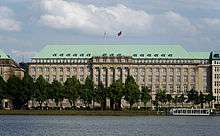
The Hamburg-Amerikanische Packetfahrt-Aktien-Gesellschaft for shipping across the Atlantic Ocean was founded in Hamburg. In 1912, Hapag built the first of their "Big Three" ocean liners; the Imperator, followed by her sister Vaterland. The third sister, Bismarck, was under construction at the outbreak of World War I and was completed after the war for White Star Line as the Majestic. These were the first liners to exceed 50,000 gross tons and 900 feet in length. During World War I, the majority of Hapag's fleet of 175 ships were wiped out, and most of the surviving ships (including the "Big Three") had to be turned over to the winning side as war reparations. After war's end, Hapag rebuilt its fleet with much smaller ships than before the war, but their fleet was again mostly wiped out during World War II, with surviving ships turned over to allied powers.[4]
North German Lloyd
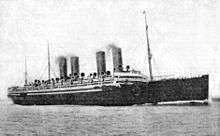
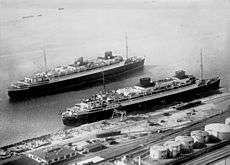
Norddeutscher Lloyd (NDL) was formed in 1857 in the City-State of Bremen, offering passenger and cargo transportation between Bremen and New York, with an emphasis on emigration to the United States. Service started in June 1858 with the Bremen, the first of four steamships,[5] and the company established its American base at Hoboken, New Jersey. NDL eventually built a large fleet of ships that carried many thousands of emigrants westwards, with around 218,000 passengers transported across the Atlantic in 1913 alone.[6]
The outbreak of World War I resulted in the internment of 32 vessels in US ports, a status later changed to confiscation when the US entered the war in 1917.[7] Likewise, its Hoboken base was confiscated, and turned over to the US Navy, which used it as a transshipping point for the duration.[8] As with HAPAG, those NDL ships surviving the war eventually were confiscated as reparation, leaving the company to start over from scratch.
US-Operations were resumed in 1922, when NDL was able to purchase its former base from the United States Alien Property Administrator. NDL launched a new Bremen and Europa in 1929–30.[8]
During World War II, NDL repeated its World War I experience, with some parts of its fleet again being interned at the outbreak of the war, while a number of vessels remained under NDL control.[9] One such exception was the Bremen, which raced across the Atlantic, and achieved protection at Murmansk in 1939, before eventually making a dash for Bremerhaven, where she was ultimately destroyed by a fire in 1941.[10]
Passenger service resumed in 1954 with the Gripsholm formerly belonging to the Swedish American Line (the ship was renamed to MS Berlin only the following year).[11] Later two other second-hand ships, SS Bremen (formerly Pasteur) and MS Europa (formerly Swedish American Line's Kungsholm), were purchased.[8]
NDL attained several speed records over the years. Notable among them was the record for the run between Southampton and New York of eight days in 1881, which was set by the Elbe; and the record for the fastest transatlantic crossing set by the new Bremen in 1929 (see Blue Riband).[8]
Hapag-Lloyd
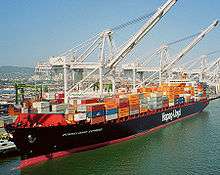
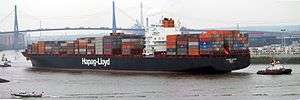
Hapag and NGL continued to compete until establishing a joint-venture container line. The "Hapag-Lloyd Container Line", founded in 1967 and operating from 1968 onward, was established to share the huge investments related to the containerisation of the fleets. Both companies finally merged on September 1, 1970 under the name Hapag-Lloyd.[3]
Hapag-Lloyd was acquired in 1998 by Preussag AG (since 2002 called TUI AG (Hanover)), a tourism conglomerate, and became its fully owned subsidiary in 2002.[12]
In 2008 TUI announced an intention to sell its entire stake in Hapag-Lloyd shipping activities before the end of that year. Industry speculation predicted a sale price of approximately $US5.9 billion.[13]
Airline activities
Hapag-Lloyd founded the charter airline Hapag-Lloyd Flug in 1972, buying a few Boeing 727s to fly its cruise passengers from Germany to the cruises' ports of call. The airline eventually added some regular passenger flights as well. Hapag-Lloyd Flug used the IATA code HF and became a directly owned subsidiary of Preussag AG in 1999.[14]
Mergers and acquisitions
CP Ships Limited
On 21 August 2005, TUI AG agreed to acquire the Canadian business CP Ships Limited for €1.7 billion (US$2.0 billion) in cash. The deal, which was approved by the boards of both CP Ships, TUI, and the shareholders, was a success, and made the combined fleet the fifth-largest by capacity in the worldwide container shipping market.[15]
Hamburg Süd
In late 2012, Hapag-Lloyd announced it was considering the possibility of a merger with its smaller compatriot Hamburg Süd. The merger plans were scotched when Hamburg Süd's shareholders and owners did not reach an agreement with the Hapag-Lloyd stakeholders.[16] After this event, Hamburg Süd remained a private, independent company until December 2016, when the container transport division of Danish logistics and energy company Maersk, announced it would purchase Hamburg Süd.[17]
Compañía Sud Americana de Vapores (CSAV)
In 2014, Hapag-Lloyd took over the container business of Chile's Compañía Sud Americana de Vapores SA (CSAV), with the latter becoming a major shareholder of Hapag-Lloyd. This made Hapag-Lloyd the fourth-largest container-shipping company in the world at the time.[18][19]
United Arab Shipping Company (UASC)
In April 2016, Hapag-Lloyd announced it was in merger talks with the United Arab Shipping Company (UASC). The merger was agreed upon later in 2016 and the integration between the two companies was completed in 2017. At the time of the merger, UASC was reported to be the world's 10th largest liner shipping company with a fleet of 56 ships and a market share of 2.7 percent.[20] As a result of the merger, Hapag-Lloyd strengthened its position as the world's fifth largest container transporter in terms of vessel capacity, ahead of Taiwan's Evergreen Line. As a result of the merger, the former shareholders of UASC would become the largest shareholder in the new entity, whilst Hapag-Lloyd would absorb all operations and assets of UASC.[21]
Historically United Arab Shipping Company was jointly established in July 1976 by the six shareholding governments of the Arab states of the Gulf (Bahrain, Iraq, Kuwait, Qatar, Saudi Arabia and U.A.E).[22] Originally based in Kuwait, its corporate headquarters then moved to Dubai during the Iraqi conflict, and only some departments were moved back after the war.[23]
The UASC fleet operated more than 45 services, connecting the Middle East to Europe, the Mediterranean, Indian Sub-continent, Far East, West Africa and the Americas.[24] Its network covered over 220 ports, offering containerized and conventional cargo shipping by a fleet of 58 owned and chartered vessels.[25] On June 29, 2016, UASC's six shareholding states voted unanimously to approve the proposed merger. The deal gave a relative valuation of the two businesses at 72 percent for Hapag-Lloyd and 28 percent for UASC. At the time of the merger, UASC was 51 percent owned by Qatar and 35 percent owned by Saudi Arabia government, with the remainder held by other Arab states.[26]
Services and business areas
Container transportation
- Hapag-Lloyd's cellular vessel fleet and TEU ownership ranks fifth globally in terms of capacity, ahead of Taiwan's Evergreen Line and behind China's Cosco Shipping.
- Hapag-Lloyd transports containerized cargo on several major trade routes around the world. It has a prominent market presence and brand recognition in Latin America, Middle East, trans-Atlantic, and trans-Pacific trades, among others.
- Hapag-Lloyd is currently the largest member of the Transport High Efficiency vessel-slot sharing alliance, which was created in April 2017 and also includes Taiwan's Yang Ming Line and the Japanese carrier Ocean Network Express.[27][28]
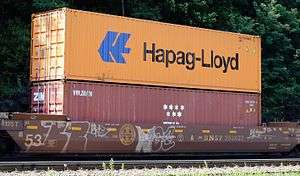
Former Hapag-Lloyd AG cruise ships
Hapag-Lloyd AG has not been involved in the cruise business since 2006, and should not be confused with Hapag-Lloyd Cruises GmbH, a subsidiary of TUI AG. Only vessels formerly operated by Hapag-Lloyd AG are listed here.
Chartered ships
- MS Columbus - 1997–2012.
- MS Hanseatic - 1996-2018.
- MS Finnstar - 1979–1980.
See also
- Top 20 container shipping companies
- CMA-CGM
References
- . Hapag-Lloyd AG https://www.hapag-lloyd.com/en/ir/company/key-figures.html#tabnav. Retrieved 6 December 2019. Missing or empty
|title=(help) - HL Quarterly financial report 1 January to 30 September 2019, p. 4
- "Hapag-Lloyd". Castles of the Seas. Retrieved 22 September 2019.
- "Hamburg America Line". Ships List. Archived from the original on 2011-05-25. Retrieved 22 September 2019.
- Kludas, Arnold (1991). Die Seeschiffe des Norddeutschen Lloyd 1857 bis 1919, Vol. 1. Herford. p. 10.
- Drechsel, Erwin (1994). Norddeutscher Lloyd Bremen 1857-1970. History, Fleet, Ship Mails, Vol. I. Vancouver. p. 410.
- Drechsel, Edwin (1995). Norddeutscher Lloyd Bremen 1857-1970. History, Fleet, Ship Mails, Vol. II. Vancouver. p. 1.
- Kenneth T. Jackson (1995). The Encyclopedia of New York City. The New York Historical Society; Yale University Press. p. 854.
- NDL Annual Report 1939-1948. P. 4.
- Huchthausen, Peter A. (2005). Shadow voyage : the extraordinary wartime escape of the legendary SS Bremen. Hoboken, N.J.: J. Wiley & Sons. ISBN 0-471-45758-2. OCLC 55764562.
- Drechsel, Erwin (1995). Norddeutscher Lloyd, Vol. II. Vancouver. p. 493.
- "Hapag-Lloyd CEO: reduction in operational costs needed", Arabian Supply Chain, 30 March 2015. Accessed 23 July 2015.
- "Hapag-Lloyd sales rise as Tui confirms shipping exit plans". Lloyd's List Daily Commercial News. Informa Australia. 2008-08-15. Retrieved 2008-08-15.
- "Facts and Figures." Hapagfly. 1 June 2005. Retrieved on 29 May 2009.
- "Wayback Machine". October 12, 2017. Archived from the original on 2017-10-12.
- "Hapag-Lloyd merger with Hamburg-Sued called off". March 24, 2013 – via uk.reuters.com.
- "Oetker group sells shipping business to Maersk | DW | 01.12.2016". DW.COM.
- "Regulators clear way for merger of Hapag-Lloyd and Vapores". Reuters. 2 December 2014. Archived from the original on 24 September 2015. Retrieved 2 December 2014.
- "Approval for World's Fourth Largest Container Shipping Line Granted" Handy Shipping Guide, 2 December 2014. Accessed: 12 December 2014
- Barki, Deniz; Délèze-Black, Lucy, eds. (2017). Review of Maritime Transport 2017 (PDF). New York: United Nations Conference on Trade and Development (UNCTAD). p. 30. ISBN 978-92-1-362808-9.
The Review of Maritime Transport 2017 covers data and events from January 2016 until June 2017. (p. viii)
- "Talks between Hapag-Lloyd and United Arab Shipping Company". 21 April 2016. Retrieved 26 May 2016.
- "United Arab Shipping joins the frontline as other shipping companies retreat". The Express Tribune. December 16, 2012.
- "UASC MOVING BACK TO KUWAIT SOME DIVISIONS TO STAY IN DUBAI". www.joc.com. June 30, 1992.
- "Hapag-Lloyd Investor Presentation" (PDF).
- "UASC signs USD 2.5 bln deal with Hyundai". Shipping Watch. 30 August 2013. Retrieved 21 September 2019.
- Lo, Joe (July 1, 2016). "UASC and Hapag-Lloyd's merger progresses".
- "Hapag-Lloyd and Asian lines form six-member alliance". Lloyd's List. May 13, 2016.
- "Hapag-Lloyd vows to smooth the alliance transition". Safety at Sea.
External links
| Wikimedia Commons has media related to Hapag-Lloyd. |
| Wikimedia Commons has media related to Norddeutscher Lloyd. |
- Hapag-Lloyd
- Hapag-Lloyd Cruises
- TUI AG (Hanover)
- Provisioning a Transatlantic Liner 1901 Norddeutscher Lloyd S.S. Deutschland
- List of NDL ships with pictures
- Norddeutscher Lloyd Bremen / North German Lloyd Passenger Lists